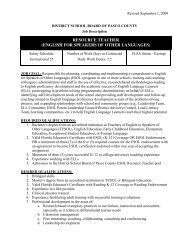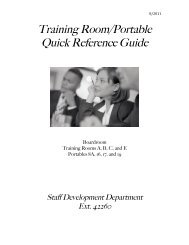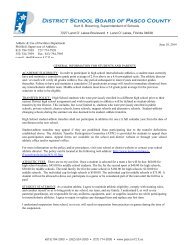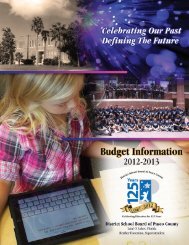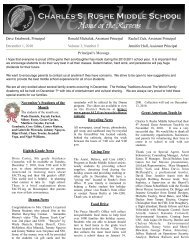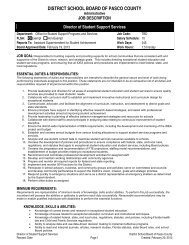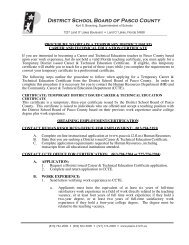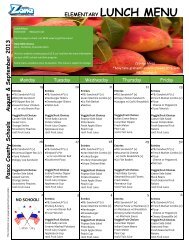Annual Report for 2010-2011 - Pasco County Schools
Annual Report for 2010-2011 - Pasco County Schools
Annual Report for 2010-2011 - Pasco County Schools
Create successful ePaper yourself
Turn your PDF publications into a flip-book with our unique Google optimized e-Paper software.
Foreword<br />
<strong>Pasco</strong> <strong>County</strong> School Board<br />
Allen Altman<br />
District 1<br />
Joanne Hurley<br />
District 2<br />
Cynthia Armstrong<br />
District 3<br />
Alison Crumbley<br />
District 4<br />
Steve Luikart<br />
District 5<br />
Heather Fiorentino<br />
Superintendent<br />
Ruth B. Reilly<br />
Assistant Superintendent <strong>for</strong> Curriculum and Instructional Services<br />
Olga Swinson, CPA<br />
Chief Finance Officer<br />
Renalia S. DuBose, Esq.<br />
Assistant Superintendent <strong>for</strong> Administration<br />
David Scanga, Ed.D.<br />
Assistant Superintendent <strong>for</strong> Elementary <strong>Schools</strong><br />
Tina Tiede<br />
Assistant Superintendent <strong>for</strong> Secondary <strong>Schools</strong><br />
Tom Barker<br />
Executive Director <strong>for</strong> Elementary <strong>Schools</strong><br />
Beth Brown<br />
Executive Director <strong>for</strong> Secondary <strong>Schools</strong><br />
The purpose of the Superintendent’s <strong>Annual</strong> <strong>Report</strong> is to provide in<strong>for</strong>mation to assist the district staff<br />
in both monitoring progress toward goals and planning <strong>for</strong> the future. Research reminds us how<br />
important the analyses of data are to healthy organizations (Wheatley, 1999; Stiggins, 1999). Data<br />
provide an indication of where an organization is and give direction to needed changes. Within this<br />
document various tables and charts will provide data related to starting points, current levels of<br />
per<strong>for</strong>mance, and future targets. This report is intended <strong>for</strong> use by school and district level<br />
administrators, school board members, and others who may need detailed in<strong>for</strong>mation about district<br />
initiatives. It is our hope that this report will assist its readers as they prepare to meet the opportunities<br />
and challenges of <strong>Pasco</strong>’s Vision and Strategic Plan. <strong>Report</strong> prepared December <strong>2011</strong><br />
1
District and Community Profile<br />
(rev. 11/11)<br />
The District School Board of <strong>Pasco</strong> <strong>County</strong><br />
(DSBPC), established in 1887, is the 11th largest<br />
district in Florida and the 54th largest district<br />
nationally (EIAS Publications, <strong>2010</strong>d; Common<br />
Core of Data, <strong>2011</strong>). For the <strong>2011</strong>-2012 school<br />
year, the district has 46 elementary, 15 middle<br />
schools, 13 high schools, 4 education centers,<br />
1 virtual school (K-12) and 5 charter schools<br />
serving almost 67,000 students.<br />
The Department of Education Fall PreK-12<br />
Student Membership <strong>Report</strong> indicates that<br />
<strong>Pasco</strong> schools grew by over 4,375 students<br />
between 2005 and 2009 (EIAS Publications,<br />
<strong>2010</strong>e). It is projected that <strong>Pasco</strong>’s growth of<br />
total PreK-12 student enrollment will reach<br />
75,936 by the 2020-2021 school year<br />
(Education Estimating Conference, <strong>2011</strong>). The<br />
district’s projected growth will continue to<br />
demand the construction of new schools. The<br />
district’s increasing enrollment is also reflected<br />
in the number of students served by the Food<br />
and Nutrition (FNS) and Transportation<br />
departments. In the <strong>2010</strong>-<strong>2011</strong> school year,<br />
FNS staff served over 58,400 breakfast and lunch<br />
2<br />
11 th Largest District in Florida<br />
It is projected that <strong>Pasco</strong>’s total student<br />
enrollment will reach nearly 76,000 by<br />
the 2020-2021 school year.<br />
meals on an average daily basis, over 600 more<br />
meals than the year be<strong>for</strong>e (N. Westmoreland,<br />
personal communication, October 31, <strong>2011</strong>). In<br />
<strong>2010</strong>-<strong>2011</strong>, school buses transported 35,089<br />
students twice daily and the DSBPC<br />
Transportation Department ranks 55 th in the<br />
nation with 398 route buses in the fleet (T. Kledzik,<br />
personal communication, October 31, <strong>2011</strong>).<br />
<strong>Pasco</strong> <strong>County</strong> is just south of the geographical<br />
center of Florida and north of the Tampa-St.<br />
Petersburg area. Located on the Gulf of Mexico,<br />
<strong>Pasco</strong> is part of a nine-county region referred to<br />
as the “Nature Coast.” It was created in 1887<br />
from the southern part of Hernando <strong>County</strong>,<br />
named after Samuel <strong>Pasco</strong> who served in the<br />
Confederate Army, the state legislature and in<br />
the United States Senate from 1887 to 1899.<br />
The county has experienced significant<br />
population growth since the 1960s. This growth<br />
began on the county’s west side along the gulf<br />
coast, but is now occurring most rapidly in the<br />
central areas and along the county lines just<br />
north of Tampa and Pinellas counties. <strong>Pasco</strong>’s<br />
745 square miles of land area contain a mix of<br />
suburban and rural communities (<strong>Pasco</strong> <strong>County</strong><br />
Home, <strong>2011</strong>).<br />
<strong>Pasco</strong> <strong>County</strong> is Florida’s 12 th most populous<br />
county, containing 2.5% of Florida’s citizens.<br />
The county’s population has increased from<br />
344,768 as reported by Census 2000 to<br />
464,697 in <strong>2010</strong> - a population change of<br />
approximately 34.8% (Florida <strong>County</strong> Profiles,<br />
<strong>2011</strong>). The collapse of the housing market,<br />
along with a loss of jobs, is likely to keep<br />
population growth at low levels. As the national<br />
economy recovers and the excess supply of<br />
housing in Florida is absorbed, it is expected<br />
that economic growth will pick up again and<br />
increase to more normal levels during the next<br />
decade (University of Florida News, <strong>2011</strong>).<br />
By year 2015, the population will increase to a
projected 479,078 and by year 2030 to over<br />
527,000 returning to normal average increases<br />
(Florida <strong>County</strong> Profiles, <strong>2011</strong>). Even with<br />
current economic conditions and possible loss<br />
of population, <strong>Pasco</strong> presently ranks the 12 th<br />
fastest growing county in Florida and the 74 th<br />
fastest growing county in the United States<br />
(U.S. Census Bureau, <strong>2010</strong>f).<br />
The majority of <strong>Pasco</strong>’s residents are in the 25<br />
to 44 (25%) and 45 to 64 (26%) age ranges. In<br />
2009, the median age was 43.2 years compared<br />
to 40.1 years <strong>for</strong> the state. About 21% of the<br />
total population was age 65 or older, as<br />
compared to the state’s 17%. Thirty percent<br />
(30%) of county residents were born in Florida<br />
and nine percent were <strong>for</strong>eign born. Families<br />
made up 67% of the households in <strong>Pasco</strong> with<br />
an average household size of 2.7 people and<br />
average family size of 3.3 people (U.S. Census<br />
Bureau, <strong>2010</strong>a). Less populated than adjacent<br />
Pinellas or Hillsborough Counties, <strong>Pasco</strong> is<br />
noted as being in the “land of opportunity <strong>for</strong><br />
the region” and an economic development and<br />
growth area <strong>for</strong> West Central Florida (Business<br />
Development, <strong>2011</strong>).<br />
In 2009, the U.S. Census Bureau reported that<br />
<strong>Pasco</strong> <strong>County</strong> had 172,000 housing units, of<br />
which 68% were single-unit structures, 22%<br />
were mobile homes and 10% were multi-unit<br />
structures. Figures <strong>for</strong> owner-occupied housing<br />
units remained approximately the same from<br />
2008 to 2009 at 78% while the percent of<br />
renter-occupied housing units decreased<br />
slightly from 23% to 22% over the same period.<br />
<strong>Report</strong>edly, <strong>for</strong>ty-seven percent of owners with<br />
mortgages, 16% of owners without mortgages<br />
and 57% of renters in <strong>Pasco</strong> <strong>County</strong> spent 30%<br />
or more of their household income on monthly<br />
owner costs (U.S. Census Bureau, <strong>2010</strong>d).<br />
The <strong>Pasco</strong> Economic Development Council<br />
sites the DSBPC as the largest employer in<br />
<strong>Pasco</strong> <strong>County</strong> with over 9,350 instructional<br />
and non-instructional personnel. Other large<br />
employers include the <strong>Pasco</strong> <strong>County</strong><br />
Government with over 2,200 employees and the<br />
State of Florida Government with almost 1,300<br />
employees. According to the Florida Research<br />
& Economic Database (FRED) (<strong>2011</strong>), 1st Quarter <strong>2010</strong>, retail trade (18%), health care and<br />
social assistance (18%), and accommodation<br />
and food services (10%) remain the major<br />
industries in <strong>Pasco</strong>. Among the largest major<br />
occupational groups were Office and<br />
Administrative Support Occupations (with 19%<br />
of the estimated employment), followed by<br />
Sales and Related Occupations (with 13%), and<br />
Food Preparation and Serving Related<br />
Occupations (with 9%).<br />
<strong>Pasco</strong> <strong>Schools</strong> at a Glance<br />
46 Elementary <strong>Schools</strong><br />
15 Middle <strong>Schools</strong><br />
13 High <strong>Schools</strong><br />
4 Education Centers<br />
1 Virtual School<br />
5 Charter <strong>Schools</strong><br />
<strong>2011</strong><br />
3
4<br />
<strong>Pasco</strong> had the largest growth in<br />
minorities in the whole state <strong>for</strong> the<br />
decade since the 2000 census.<br />
According to 2009 census data, 85% of people<br />
25 or older were high school graduates and<br />
18% had a bachelor’s degree or higher. The<br />
state educational figures were 85% and 25%,<br />
respectively (U.S. Census Bureau, <strong>2010</strong>c).<br />
Compared to data from the 2000 census when<br />
only 78% of <strong>Pasco</strong> residents completed high<br />
school and 13% had bachelor degrees or<br />
higher, the most current statistics indicate the<br />
educational level of the county’s population has<br />
risen significantly (U.S. Census Bureau, <strong>2010</strong>e).<br />
As of October <strong>2011</strong>, the total minority<br />
population served in the district was over<br />
22,000 students. This represents almost 32% of<br />
the district’s total student body (18.97%<br />
Hispanic, 5.7% Black, 2.5% Asian/Pacific, 4%<br />
Multi-racial, less than 1% Indian) (<strong>Pasco</strong> Star,<br />
retrieved October 31, <strong>2011</strong>). <strong>Pasco</strong> had the<br />
largest growth in minorities in the whole state<br />
<strong>for</strong> the decade since the 2000 census -181%<br />
(Tampa Bay Area Hispanic Population, <strong>2010</strong>).<br />
From 1979 to 2009, the greatest numerical<br />
gains have occurred in the Hispanic population<br />
in both <strong>Pasco</strong>’s public schools and the state.<br />
From 1979 to 2009, the number of minority<br />
students grew from 1,607 (6.5%) to 19,430<br />
(29%), a percent change of 22.5%. The<br />
percentage of white students in <strong>Pasco</strong>’s public<br />
schools dropped from 93.54% in 1979 (EIAS<br />
Publications, <strong>2010</strong>c) to 67.04% in <strong>2011</strong> (<strong>Pasco</strong><br />
Star, retrieved October 31, <strong>2011</strong>). From 2000-01<br />
to 2009-10, the total number of English<br />
Language Learners (ELL) increased from 1,433<br />
students (2.9% of total student membership) to<br />
2,872 students (4.3% of total student<br />
membership) (EIAS Publications, <strong>2010</strong>b). The<br />
percentage of ELL students in <strong>Pasco</strong>’s public<br />
schools has continued on a gradual, long-term<br />
upward trend <strong>for</strong> the last decade. Although the<br />
majority of ELL students are Spanish-speaking,<br />
these students come from 67 different countries<br />
and speak over 45 languages (A. Leonard,<br />
personal communication, February 8, <strong>2011</strong>).<br />
Approximately 12% of the students in <strong>Pasco</strong><br />
are special education (ESE) students (Program<br />
Evaluation, <strong>2010</strong>). The district continues to plan<br />
systemic improvements so that all special<br />
needs students will benefit from their<br />
educational experience.<br />
As detailed above, <strong>Pasco</strong> <strong>County</strong> is located in<br />
the southeastern United States — a region<br />
that is both economically and culturally<br />
diverse. Over half of the district’s students<br />
come from families who live in low<br />
socioeconomic conditions (N. Westmoreland,<br />
personal communication, October 31, <strong>2011</strong>).<br />
The 2009 median household income and 2009<br />
per capita income figures <strong>for</strong> <strong>Pasco</strong> <strong>County</strong>,<br />
Florida and the United States are reflected in<br />
the table (U.S. Census Bureau, <strong>2010</strong>b).<br />
Figures from 2009 show that approximately<br />
13% of the <strong>Pasco</strong> <strong>County</strong> population lived<br />
below the poverty level and 17% of related<br />
children under 18 were living in poverty. In<br />
addition, 9% percent of all families and 21% of<br />
families with a female head of household had<br />
incomes below the poverty level (U.S. Census<br />
Bureau, <strong>2010</strong>a).
2009 Income Data <strong>Pasco</strong> <strong>County</strong> Florida United States<br />
Median Household Income $40,154 $44,736 $50,221<br />
Per Capita Income $21,524 $24,692 $26,409<br />
Estimates show that the number of people living<br />
in poverty has been growing steadily since 2006<br />
in <strong>Pasco</strong> resulting from the ongoing economic<br />
downturn. An increase of children younger than<br />
18 are falling into poverty as their parents lose<br />
jobs (1 in 5 Tampa Bay Area Kids, <strong>2010</strong>).<br />
According to the Florida Research and<br />
Economic Database (FRED) (<strong>2011</strong>), <strong>Pasco</strong>’s<br />
unemployment rate of 11.7% <strong>for</strong> September<br />
<strong>2011</strong> was slightly higher than Florida’s rate of<br />
10.6% and significantly higher than the US 8.8%<br />
rate <strong>for</strong> the same period. The average weekly<br />
wage earned by <strong>Pasco</strong> <strong>County</strong> residents <strong>for</strong> the<br />
last period available (3rd Quarter <strong>2010</strong>) was $608<br />
as compared to $779 <strong>for</strong> the state. This is<br />
equivalent to $15.20 per hour or $ 31,616 per<br />
year, assuming a 40-hour week was worked the<br />
year around. At this income level, a family of five<br />
or more would be eligible to participate in the<br />
free meal program and a family of three or more<br />
would qualify <strong>for</strong> the reduced price meal<br />
program (District School Board of <strong>Pasco</strong> <strong>County</strong>,<br />
<strong>2011</strong>). As of May <strong>2011</strong>, approximately 53% of<br />
the students served by the DSBPC qualified <strong>for</strong><br />
free/reduced lunch and 50 of the district’s 78<br />
traditional public schools and education centers<br />
had a free/reduced lunch rate of 50% or greater<br />
(N. Westmoreland, personal communication,<br />
October 31, <strong>2011</strong>). The percent of food stamp<br />
recipients in <strong>Pasco</strong> increased from 66,384 to<br />
75,077 in one year (Waveny & Newcomer, <strong>2011</strong>),<br />
further indication of the economic impact<br />
<strong>Pasco</strong>’s citizens are experiencing.<br />
<strong>Pasco</strong> <strong>County</strong> children are found in a variety of<br />
family environments ranging from extended<br />
families to single parent homes. The Florida<br />
Department of Health reported that the number<br />
of births in <strong>Pasco</strong> to unwed teenage mothers<br />
aged 15-19 decreased from 489 (22%) in 2007<br />
to 435 (21%) in 2008 (FloridaCHARTS.com,<br />
<strong>2011</strong>). <strong>Pasco</strong>’s culturally diverse students from<br />
impoverished homes may lack the same<br />
educational foundation and opportunities<br />
experienced by their middle and upper class<br />
peers. Prevailing economic conditions<br />
frequently require one or both parents to work<br />
outside of the home and, in fact, 62% of<br />
families with children 6 to 17 years old have<br />
both parents in the labor <strong>for</strong>ce. Of married<br />
couples with children under 18, over 70% of the<br />
females are employed either with or without<br />
their husbands in the labor <strong>for</strong>ce. Of female<br />
Approximately 53% of the students<br />
served by the DSBPC qualified <strong>for</strong><br />
free/reduced lunch.<br />
5
single parent households, 86% are in the labor<br />
<strong>for</strong>ce (U.S. Census Bureau, <strong>2010</strong>g). As a result,<br />
large numbers of parents are required to find<br />
quality childcare and after school activities <strong>for</strong><br />
their children.<br />
Data from the <strong>2011</strong> school year reflect<br />
remarkable per<strong>for</strong>mance of <strong>Pasco</strong>’s high<br />
schools as demonstrated by their continued<br />
improvement of graduation and dropout rates.<br />
The district’s National Governors Association<br />
(NGA) Compact Graduation Rate; which<br />
includes standard and special diplomas but<br />
excludes GEDs, both regular and adult;<br />
continued to exceed statewide totals growing<br />
from 77.8% in 2009 to 85.5% in <strong>2011</strong> as these<br />
numbers compare favorably to respective totals<br />
of 76.3% and 80.1% over the same period at<br />
the state level. The district’s NGA graduation<br />
rate has increased by approximately 14% over<br />
the five-year period from 2006 (68.1%) to <strong>2010</strong><br />
(81.8%) (EIAS Publications, <strong>2010</strong>a).<br />
6<br />
Current data also reveal that the dropout rate is<br />
continuing to decrease from previous year<br />
district and state level totals. In <strong>2011</strong>, the<br />
district dropout rate declined to 1.0% from<br />
1.2% in 2009. The district’s dropout rates are<br />
also noticeably less than the 1.9% in <strong>2011</strong> and<br />
2.3% in 2009 reported totals at the state level.<br />
Improvements in the graduation and drop out<br />
rates are evidence of steps the District has<br />
taken to provide a rigorous and relevant<br />
learner-focused curriculum and improve<br />
student per<strong>for</strong>mance. As growth and changing<br />
demographics alter <strong>Pasco</strong>’s education<br />
landscape, District re<strong>for</strong>m plans will continue to<br />
focus on building strong “student-centered<br />
school environments” that result in a higher<br />
percentage of students graduating from high<br />
school ready <strong>for</strong> college and work, more<br />
students per<strong>for</strong>ming on grade level, and<br />
narrowing the achievement gap.<br />
Data from the <strong>2011</strong> school year reflect<br />
remarkable per<strong>for</strong>mance of <strong>Pasco</strong>’s high schools as<br />
demonstrated by their continued improvement<br />
of graduation and dropout rates.
20<br />
<strong>2010</strong>-<strong>2011</strong> Highlights by Goal Area<br />
Prepare Students <strong>for</strong> Global Citizenship<br />
All Students will Meet or Exceed High Academic Standards<br />
• The District has earned an outstanding grade of A or B each year since 2003.<br />
• <strong>Pasco</strong> was ranked as the highest school district in the bay area by the state in <strong>2011</strong>.<br />
• The District graduation rate of 88.5% led the Tampa Bay area, and was a full eight points above<br />
the state average (Florida Calculation Model).<br />
• The District’s rigorous curriculum is aligned to changes in state standards and reflects<br />
movement to the Common Core Standards.<br />
• Trainings in the Common Core Standards reflect increased rigor.<br />
• Curriculum maps have been provided to ensure that all teachers are aware of the most<br />
essential, prioritized areas of the curriculum.<br />
• District curriculum is integrated across content areas to ensure pervasive immersion of<br />
key concepts.<br />
• Common benchmark assessments have been designed to reflect increased rigor of revised<br />
state standards.<br />
• The District provided staff development to ensure all instructional staff members are kept<br />
abreast of changes in curriculum.<br />
• Training in the Problem-Solving Response to Intervention (PS/RtI) framework has been provided<br />
in how to differentiate support to struggling students.<br />
• Training in CRISS Strategies and Learning-Focused Strategies has been provided to ensure best<br />
practices are utilized with fidelity in order to focus on higher order thinking skills.<br />
The achievement gap closes as a result of NCLB subgroups meeting academic proficiency<br />
• In 2009-<strong>2010</strong>, 63% of <strong>Pasco</strong>’s ESE students earned a standard high school diploma (compared<br />
to 53% at the state level), and 82% of <strong>Pasco</strong>’s ESE students were served in regular education<br />
environments at least 80% of the time. Both of these accomplishments reflect tremendous<br />
improvement and are significantly higher than the state average.<br />
• Differentiated support has been provided to highest need schools.<br />
• All schools provided support and flexibility and used the continuum of services to place ESE<br />
students in the most appropriate and least restrictive learning environment.<br />
• Title I schools received differentiated support, professional development and financial<br />
assistance to decrease the achievement gap.<br />
• Read 180 has been implemented as a strategy to support literacy at the secondary level.<br />
• Innovative Science and Technology Camps were provided <strong>for</strong> Title I students in order to provide<br />
hands-on learning opportunities and bridge the experiential gap that exists between<br />
economically disadvantaged students and their more affluent peers.<br />
• The District was recognized as the top National Magna Award winner by the National School<br />
Board Association <strong>for</strong> innovative Title I summer programs.<br />
• Resources were provided <strong>for</strong> English Language Learner (ELL) students to develop English<br />
language proficiency.
• Bilingual Instructional Assistants received additional professional development to support<br />
struggling students.<br />
• Training was provided to assist teachers in addressing the needs of students in all subgroups<br />
found in the lowest quartile.<br />
• Progress monitoring was implemented to ensure students receive differentiated support.<br />
• The Multi-Tiered System of Support (MTSS) and PS/RtI framework was implemented throughout<br />
the District to provide appropriate support and intervention strategies.<br />
All students graduate prepared <strong>for</strong> success in the present and future economies<br />
• The District opened at least one certified career academy in every high school.<br />
• The District’s drop-out rate plummeted to 1.0%.<br />
• The District worked collaboratively with the business community to develop a five year plan <strong>for</strong><br />
meeting the work<strong>for</strong>ce needs of the community.<br />
• The District expanded the Global Partnership Project to include 22 countries, enabling students<br />
and teachers to partner with their international peers on global learning projects.<br />
• The District increased access to accelerated coursework (AP, IB, Dual Enrollment and Gifted).<br />
• An Early Warning System was implemented in schools to ensure that at-risk students are<br />
identified and supported in order to ensure successful outcomes.<br />
• <strong>Schools</strong> implemented the 9th grade Academy, a small “school within a school,” where students<br />
receive assistance to ensure a smooth transition to high school, resulting in increased outcomes<br />
<strong>for</strong> students.<br />
• A wide variety of diverse career preparation supports were available at all secondary schools in<br />
order to encourage students to explore career paths.<br />
• Online course recovery programs were utilized to help students recover credit <strong>for</strong> failed courses<br />
in order to stay on track <strong>for</strong> high school graduation.<br />
The District supports schools and is accountable <strong>for</strong> results<br />
• The District embarked upon a school improvement journey, starting with work at Title I schools<br />
and culminating in the Multi-Tiered System of Support (MTSS) model, which ensures that<br />
strategic support strategies are implemented in struggling schools through the ASSIST process.<br />
• School Advisory Council (SAC) liaisons were provided in order to maximize support and ensure<br />
skill alignment.<br />
• The District participated in feeder pattern meetings to support vertical alignment.<br />
• The District Vision Committee monitored the metrics outlined in the Strategic Plan and began an<br />
intensive revision of the District’s Guiding Principles and Vision to reflect 21st century needs.<br />
Teachers and students use data to in<strong>for</strong>m teaching and learning<br />
• Assessment <strong>for</strong> Learning training has been provided to administrators, coaches and<br />
teacher leaders.<br />
• Core K-12 Assessments and Florida Assessment <strong>for</strong> Instruction in Reading (FAIR) Assessments<br />
have been utilized to make data-based decisions that guide instructional practices.<br />
• All instructional staff were trained in best practices through Learning–Focused Strategies (LFS).<br />
21
• The professional development system was strengthened to ensure appropriate implementation<br />
and monitoring.<br />
• New teacher and administrative evaluation systems with a strong data component were selected.<br />
• <strong>Pasco</strong> STAR was enhanced to increase employees’ access to data.<br />
• The coaching model was used as a best practice to build capacity of teachers.<br />
• The District continued to move toward more rigorous assessments (e.g., FCAT 2.0, Algebra I<br />
End of Course exams).<br />
Provide Equitable Support Systems<br />
The District and schools recruit, retain and train highly skilled employees<br />
• All instructional staff and administrators received professional development in best practices.<br />
• The Preparing New Principals Program (PNPP) helped to ensure that new or prospective<br />
principals receive support and mentoring, as needed.<br />
• All administrators participated in the Leading Sustainable School and District Development<br />
program (LSSD), which prepares leaders <strong>for</strong> the challenges of the 21st century school.<br />
• The Principal Pool Academy (PPA) was established to provide hands-on learning opportunities<br />
and intense professional development to ensure the brightest and best candidates are recruited<br />
and prepared <strong>for</strong> principal positions.<br />
• ARRA funds were used to provide coaching support in order to build the capacity of the<br />
District’s human resources at all schools.<br />
• High quality professional development opportunities were provided to all employees, including<br />
Non-Bargaining Non Instructional employees and School Related Personnel, in accordance with<br />
Professional Development Standards.<br />
• Mentors were provided to all first year teachers and new principals.<br />
• Internal communication systems were improved to maximize opportunities <strong>for</strong> employee<br />
feedback.<br />
• Human Resources processes were streamlined to ensure high quality applicants are available<br />
<strong>for</strong> all vacancies.<br />
• Targeted recruitment strategies were utilized to increase diversity within the District.<br />
• A competitive, comprehensive benefits package was offered to attract and retain high quality<br />
employees.<br />
• Health and Wellness Centers were opened throughout the District to compliment the benefits’<br />
package <strong>for</strong> employees. These centers offer convenient, high quality health care and most<br />
prescriptions at no charge while saving the District a great deal of money.<br />
22<br />
The District establishes and maintains safe, attractive and student-friendly facilities<br />
• The District received multiple national and state awards <strong>for</strong> the use of energy-efficient design.<br />
• The District opened the first silver and gold LEED elementary schools in Florida.<br />
• The District continued to implement an aggressive construction plan (which included opening<br />
20 new schools in five years) to reduce class sizes and ease overcrowding.
• The District’s Five Year Capital Improvement Plan ensured funds were prioritized to maintain<br />
safe and attractive schools.<br />
• The District partnered with the Tampa Bay Rays to improve the energy efficiency of existing<br />
schools.<br />
• The District continued to explore possibilities <strong>for</strong> shared use of facilities with other entities.<br />
• The District coordinated with the <strong>County</strong> and the American Red Cross throughout the year to<br />
maintain appropriate emergency management plans.<br />
• The District has standards and systems in place to ensure school safety on all campuses.<br />
• The Code of Student Conduct outlines high expectations <strong>for</strong> student behavior.<br />
• The District won state recognition <strong>for</strong> implementing its comprehensive anti-bullying policy.<br />
• The District has a close partnership with law en<strong>for</strong>cement to prevent crime on campuses and in<br />
the community through the School Resource Officer Program.<br />
• Safety drills are per<strong>for</strong>med on a regular basis to ensure preparedness <strong>for</strong> an emergency<br />
• The District’s Safety Team met regularly to ensure the safety of all students and staff on all<br />
campuses.<br />
• Penny <strong>for</strong> <strong>Pasco</strong> proceeds continue to support capital needs throughout the District.<br />
The District increases technological capacity<br />
• The District conducted a survey of high school and middle school technological resources and<br />
used the data to direct resources as needed.<br />
• The District implemented a 4 to 1 computer to student ratio at all high school and middle<br />
schools.<br />
• Trainings were provided <strong>for</strong> administrators and teachers about how to integrate technology into<br />
the classroom and how to incorporate the International Society of Technology in Education<br />
(ISTE) standards into the curriculum.<br />
• The District established technology standards <strong>for</strong> all schools.<br />
• The District provided the necessary resources (e.g., hardware, bandwidth, technical support,<br />
etc.) <strong>for</strong> schools to be able to support the online administration of assessments.<br />
• Some schools successfully piloted an open technology campus to encourage students to bring<br />
their personal technology devices to school and use them <strong>for</strong> instructional purposes.<br />
• The District moved <strong>for</strong>ward with developing a plan <strong>for</strong> implementing Enterprise Resource<br />
Planning (ERP) in order to streamline operations.<br />
• The District provided secure systems <strong>for</strong> back-up to all data.<br />
• The District centralized servers in order to increase security, streamline operations and alleviate<br />
some of the workload of technology specialists, giving them more opportunity to provide<br />
instructional support in the classroom.<br />
• The District expanded the use of Moodle <strong>for</strong> online instructional and professional development<br />
purposes.<br />
• <strong>Pasco</strong> eSchool was expanded to provide flexible learning opportunities <strong>for</strong> students.<br />
• <strong>Pasco</strong> eSchool ranked second in the state <strong>for</strong> successful student outcomes, with a completion<br />
rate of 94%.<br />
23
The District ensures fiscal responsibility and equitable distribution of resources<br />
• The District was recognized <strong>for</strong> having the lowest administrative costs in the state.<br />
• The District secured an A bond rating from Fitch.<br />
• The Superintendent and Board members protected classrooms during each round of budget<br />
cuts to ensure a well-rounded curriculum.<br />
• The District’s Five Year Capital Improvement Plan ranks all projects on the basis of need and<br />
equity.<br />
• The District continued to move <strong>for</strong>ward with planning <strong>for</strong> ERP implementation, which will<br />
streamline operations, enabling more resources to be directed to the classroom.<br />
• The District’s Purchasing Department won national awards <strong>for</strong> efficiency.<br />
• Every item brought to the Board <strong>for</strong> consideration is aligned to the Strategic Plan.<br />
• Board members held town hall meetings throughout the community to gather stakeholder<br />
feedback regarding funding priorities.<br />
• The Board held multiple workshops throughout the year to establish funding priorities.<br />
Engage Families, Communities and Businesses<br />
The District and schools communicate with and engage all stakeholders in the<br />
educational process<br />
• eSembler was utilized at middle and high school levels to ensure that parents stay actively<br />
involved in their student’s educational progress.<br />
• The <strong>Schools</strong> Connect system was used to increase parental involvement in school and districtwide<br />
activities.<br />
• Town hall meetings were held throughout the community to ensure that stakeholders are<br />
educated on financial challenges and to receive input on budget priorities.<br />
• The District has a committee structure in place that engages stakeholders from all levels in<br />
decision-making processes.<br />
• The Be There campaign was utilized to promote family involvement and volunteerism in schools.<br />
• The District increased the use of parent surveys by schools and the District regarding high<br />
interest topics in order to gather feedback.<br />
• Parent involvement coordinators worked with the District Volunteer Office to leverage volunteers<br />
at highest need schools.<br />
• The Parent Involvement Committee served as an excellent <strong>for</strong>um <strong>for</strong> gathering stakeholder<br />
input.<br />
• Career Academy Advisory Councils provided an opportunity <strong>for</strong> business partner involvement.<br />
• <strong>Schools</strong> actively engaged business partners through School Advisory Council and sponsorship<br />
opportunities.<br />
• The District was recognized as a Tampa Bay area Best Places to Work two years in a row.<br />
• The District developed a legislative plat<strong>for</strong>m, hosted legislative <strong>for</strong>ums and advocated <strong>for</strong> the<br />
needs of the District with local lawmakers.<br />
• The District worked closely with the <strong>County</strong> Commission to adequately plan <strong>for</strong> school growth<br />
and to maintain school impact fees at current level in order to support capital needs.<br />
24
• The Educator Passport Program was expanded to increase the number of business partners<br />
offering incentives to employees.<br />
• <strong>Schools</strong> developed and utilized customized parent surveys to gather meaningful input that was<br />
used to in<strong>for</strong>m School Improvement Plans.<br />
• The Florida Association of District School Superintendents conducted a survey to gather input<br />
from internal stakeholders.<br />
• The Charter School Task Force ensured close cooperation with charter schools in a proactive<br />
manner.<br />
• The District worked closely with the United School Employees of <strong>Pasco</strong> (USEP) to build a<br />
shared understanding and develop consensus around priority District initiatives, including Race<br />
to the Top and the new Teacher Evaluation System.<br />
• The District increased communication with Spanish-speaking families through the development<br />
and maintenance of the Spanish website.<br />
• District communication was provided in native languages whenever possible.<br />
• The District strengthened outreach with Hispanic organizations, including Hispanic media outlets<br />
and the <strong>Pasco</strong>-Hernando Hispanic Chamber of Commerce.<br />
• The District worked diligently to promote a positive image of the District and to educate the<br />
public about key initiatives through its comprehensive media relations ef<strong>for</strong>ts.<br />
25
District Vision Committee <strong>2010</strong> - <strong>2011</strong><br />
Rob Aguis, Community, Career and Technical Education Department<br />
Lizette Alexander, Student Services Department<br />
Kim Anderson, <strong>Pasco</strong> Middle School<br />
Mari Blank, Parent<br />
Aimee Boltze, Staff Development Department<br />
Joshua Borders, <strong>Pasco</strong> Middle School<br />
Natalie Brock, Parent<br />
Michael Cloyd, Curriculum and Instructional Services Department<br />
Elicia Cefalo-Cox, Connerton Elementary School<br />
Craig Edwards, Community Member<br />
Kelly Edwards, Mary Giella Elementary School<br />
Heather Fiorentino, Superintendent<br />
Helena Fletcher, Cypress Elementary School<br />
Charles Ford, Land O’ Lakes High School<br />
Mark Fox, Maintenance Department<br />
Elena Garcia, Curriculum and Instructional Services Department<br />
Gwen Gideon, Gulf High School<br />
Tiffany Gocsik, Veterans Elementary School<br />
Norman Graham, <strong>Pasco</strong> Elementary School<br />
Vanessa Hilton, Curriculum and Instructional Services Department<br />
Loraine Hinkle, Parent<br />
Jennifer Hull, Pine View Middle School<br />
Joanne Hurley, School Board Representative<br />
Dr. Peggy Jones, Research and Evaluation Department<br />
Jennifer Krill, Instructional Media and Technology Department<br />
Rick Kurtz, Food and Nutrition Services Department<br />
Teresa Love, Odessa Elementary School<br />
Lauren Lynch, Land O’ Lakes High School<br />
Dr. John Mann, Leadership Department<br />
Ric Mellin, Land O’ Lakes High School<br />
Robert Moore, United School Employees of <strong>Pasco</strong><br />
Jeff Morgenstein, Leadership Department<br />
Anita Mullins, Human Resources Department<br />
Rebecca Musselman, Curriculum and Instructional Services Department<br />
Melissa Musselwhite, Human Resources Department<br />
Ed Mutell, In<strong>for</strong>mation Services Department<br />
Jill Nielson, Curriculum and Instructional Services Department<br />
Michele Perry, Parent<br />
Beth Rawls, Prekindergarten Services<br />
Ruth Reilly, Assistant Superintendent <strong>for</strong> Curriculum and Instructional Services<br />
Georgina Rivera-Singletary, <strong>Pasco</strong> High School<br />
Candace Roberts, Saint Leo University<br />
Molly Robinson, Land O’ Lakes High School<br />
Frank Roder, United School Employees of <strong>Pasco</strong><br />
Dr. David Scanga, Assistant Superintendent <strong>for</strong> Elementary <strong>Schools</strong><br />
Hope Schooler, Gulf Trace Elementary School<br />
Dr. Steve Scutari, Parent<br />
Wendy Spriggs, Instructional Media and Technology<br />
Jackie Sterbins, Parent<br />
Angie Stone, Sunlake High School<br />
Erika Tonello, Schrader Elementary School<br />
Amelia Van Name Larson, Student Services Department<br />
Dr. Monica Verra-Tirado, Exceptional Student Education Department<br />
Grace Victoria, United School Employees of <strong>Pasco</strong><br />
Lynn Webb, Land O’ Lakes High School<br />
Judy Zollo, Finance Department<br />
26
References<br />
"1 in 5 Tampa Bay Area Kids Live in Poverty, Census Says." Tampa Bay Online -Breaking News<br />
Headlines, Weather & Deals -Tampa Newspapers & WFLA -TBO.com. Retrieved February 8, <strong>2011</strong>,<br />
from http://www2.tbo.com/content/<strong>2010</strong>/sep/29/but-government-programs-suchas-social-securityan/news-money/.<br />
"Business Development." (<strong>2011</strong>). Welcome to <strong>Pasco</strong> Economic Development. Retrieved February 8,<br />
<strong>2011</strong>, from http://www.pascoedc.com/Programs/Business-Development.<br />
"Common Core of Data (CCD) -Common Core of Data." District Ranking Nationally by Membership.<br />
National Center <strong>for</strong> Education Statistics (NCES) Home Page, a Part of the U.S. Department of<br />
Education. Retrieved February 8, <strong>2011</strong>, from http://www.nces.ed.gov/CCD/.<br />
District School Board of <strong>Pasco</strong> <strong>County</strong>. (<strong>2011</strong>). Interactive table showing income guidelines <strong>for</strong><br />
free/reduced priced lunch qualification. Food and Nutrition Services. Retrieved October 31, <strong>2011</strong> from<br />
http://www.pasco.k12.fl.us/nutrition/<br />
"Economic Profile." Welcome to <strong>Pasco</strong> Economic Development. Retrieved February 8, <strong>2011</strong>, from<br />
http://www.pascoedc.com/<strong>Pasco</strong>-Data/Economic-Profile.<br />
"Education Estimating Conference Public <strong>Schools</strong> PreK-12 Enrollment Archives." EDR -Office of<br />
Economic & Demographic Research. Retrieved February 8, <strong>2011</strong>, from<br />
http://edr.state.fl.us/Content/conferences/publicschools/archives/index.cfm.<br />
"EIAS Publications." (<strong>2010</strong>a). FLDOE Home. Florida Public High School Graduation and Dropout<br />
Rates, 2009-10. Retrieved February 8, <strong>2011</strong>, from http://www.fldoe.org/eias/eiaspubs/<br />
"EIAS Publications." (<strong>2010</strong>b). FLDOE Home. English Language Learners, 2009-10. Retrieved February<br />
8, <strong>2011</strong>, from http://www.fldoe.org/eias/eiaspubs/default.asp.<br />
"EIAS Publications." (<strong>2010</strong>c). FLDOE Home. Growth of Minority Student Populations in Florida’s<br />
Public <strong>Schools</strong>, 2009-10. Retrieved February 8, <strong>2011</strong>, from<br />
http://www.fldoe.org/eias/eiaspubs/archives.asp.<br />
"EIAS Publications." (<strong>2010</strong>d). FLDOE Home. Membership in Florida Public <strong>Schools</strong> Five Year<br />
Comparison of PK-12 Membership, Fall 2005 -Fall 2009. Retrieved February 8, <strong>2011</strong>, from<br />
http://www.fldoe.org/eias/eiaspubs/default.asp.<br />
"EIAS Publications." (<strong>2010</strong>e). FLDOE Home. Membership in Florida Public <strong>Schools</strong> 2009-<strong>2010</strong>.<br />
Retrieved February 8, <strong>2011</strong>, from http://www.fldoe.org/eias/eiaspubs/default.asp?style=print.<br />
27
Enrollment summary. (<strong>2011</strong>). Retrieved October 31, <strong>2011</strong>, from <strong>Pasco</strong>Star<br />
https://pascostar.pasco.k12.fl.us/.<br />
"Florida <strong>County</strong> Profiles." (<strong>2011</strong>). EDR -Office of Economic & Demographic Research. Retrieved<br />
October 31, <strong>2011</strong>, from http://edr.state.fl.us/Content/area-profiles/county/pasco.pdf.<br />
Florida Research & Economic Database (FRED) -Home Page. Retrieved October 31, <strong>2011</strong>, from<br />
http://fred.labormarketinfo.com/lmi/area/areaprofiledata.asp?session=areadetail&geo=1204000101.<br />
FloridaCHARTS.com -Florida Health Statistics and Community Health Data. Retrieved February 8,<br />
<strong>2011</strong>, from http://www.floridacharts.com/charts/chart.aspx.<br />
"Largest Employers." Welcome to <strong>Pasco</strong> Economic Development. Retrieved February 8,<br />
<strong>2011</strong>, from http://www.pascoedc.com/<strong>Pasco</strong>-Data/Labor-Employment/Largest-Employers.<br />
"ESOL Data." Retrieved October 30, <strong>2011</strong>, from <strong>Pasco</strong>Star.<br />
Moore, W. A. and Newcomer, E. P. (<strong>2011</strong>, August 8). DCF plans to shut down many Tampa Bay area<br />
offices. St. Petersburg Times. Retrieved October 30, <strong>2011</strong>, from http://www.tampabay.com/news/dcfplans-to-shut-down-many-tampa-bay-area-offices/1184952.<br />
"<strong>Pasco</strong> <strong>County</strong>, Florida." Wikipedia, the Free Encyclopedia. Retrieved February 8, <strong>2011</strong>, from<br />
http://en.wikipedia.org/wiki/<strong>Pasco</strong>_<strong>County</strong>.<br />
"<strong>Pasco</strong> <strong>County</strong> Home -About Us." Retrieved February 8, <strong>2011</strong>, from.<br />
http://portal.pascocountyfl.net/portal/server.pt/community/home/202/about_us.<br />
"Program Evaluation." FLDOE Home. LEA Profiles -<strong>Pasco</strong> <strong>2010</strong>. Retrieved February 8, <strong>2011</strong>, from<br />
http://www.fldoe.org/ese/datapage.asp.<br />
"Tampa Bay Area's Hispanic Population Is Growing." (<strong>2010</strong>). Tampa Bay Online -Breaking News<br />
Headlines, Weather & Deals -Tampa Newspapers & WFLA -TBO.com. Retrieved February 8, <strong>2011</strong><br />
from http://www2.tbo.com/content/<strong>2010</strong>/jun/25/floridas-hispanic-populationgrowing/.<br />
U.S. Census Bureau. (<strong>2010</strong>a). American FactFinder fact sheet: <strong>Pasco</strong> <strong>County</strong>, FL. Retrieved February<br />
8, <strong>2011</strong> from http://factfinder.census.gov/servlet/DatasetMainPageServlet?_lang=en&_ts=315202270<br />
163&_ds_name=ACS_2009_1YR_G00_&_program=>. 2009 American Community Survey 1-Year<br />
Estimates Data Sets Page-Data Profiles-Select <strong>for</strong> <strong>Pasco</strong> <strong>County</strong> & Florida-Social, Economic,<br />
Housing, Demographic & Narrative reports.<br />
28
U.S. Census Bureau. (<strong>2010</strong>b). Economics in <strong>Pasco</strong> <strong>County</strong>, Florida. Retrieved February 8, <strong>2011</strong>, from<br />
http://factfinder.census.gov/servlet/DatasetMainPageServlet?_lang=en&_ts=315202270<br />
163&_ds_name=ACS_2009_1YR_G00_&_program=>. 2009 American Community Survey 1-Year<br />
Estimates <strong>for</strong> <strong>Pasco</strong> <strong>County</strong> –Economics.<br />
U.S. Census Bureau. (<strong>2010</strong>c). Education in <strong>Pasco</strong> <strong>County</strong>, Florida. Retrieved February 8, <strong>2011</strong>, from<br />
http://factfinder.census.gov/servlet/DatasetMainPageServlet?_lang=en&_ts=315202270163<br />
&_ds_name=ACS_2009_1YR_G00_&_program=>. 2009 American Community Survey 1Year Estimates<br />
<strong>for</strong> <strong>Pasco</strong> <strong>County</strong> & FL -Education -%H.S. Grads & %Bachelors Degree+.<br />
U.S. Census Bureau. (<strong>2010</strong>d). Occupied housing characteristics <strong>for</strong> <strong>Pasco</strong> <strong>County</strong>, Florida. Retrieved<br />
February 8, <strong>2011</strong>, from<br />
http://factfinder.census.gov/servlet/DatasetMainPageServlet?_lang=en&_ts=315202270<br />
163&_ds_name=ACS_2009_1YR_G00_&_program=>. 2009 American Community Survey 1-Year<br />
Estimates <strong>for</strong> <strong>Pasco</strong> <strong>County</strong> & Florida-Occupied Housing Characteristics.<br />
U.S. Census Bureau. (<strong>2010</strong>e). <strong>Pasco</strong> <strong>County</strong> QuickFacts. Retrieved February 8, <strong>2011</strong> from<br />
http://quickfacts.census.gov/qfd/states/12/12101.html.<br />
U.S. Census Bureau. (<strong>2010</strong>f). Population estimates. Retrieved February 8, <strong>2011</strong>, from<br />
http://www.census.gov/popest/counties/counties.html.<br />
U.S. Census Bureau. (<strong>2010</strong>g). Presence of children by living arrangements. Retrieved February 8,<br />
<strong>2011</strong>, from http://www.factfinder.census.gov/home/saff/main.html?_lang=en 2009 American<br />
Community Survey 1-Year Estimates -Detailed Tables-<strong>Pasco</strong> <strong>County</strong>, FL C23007-Presence of Own<br />
Children Under 18 Years of Age By Family Type By Employment Status. B23008 -Age of Own<br />
Children Under 18 Years In Families and Subfamilies By Living Arrangements By Employment Status<br />
of Parents.<br />
"University of Florida News – Recession Discouraging People from Moving to Florida." (2009).<br />
University of Florida News. Retrieved February 8, <strong>2011</strong>, from<br />
http://news.ufl.edu/2009/03/23/floridapopulation-growth/.<br />
29
District School Board of <strong>Pasco</strong> <strong>County</strong><br />
7227 Land O’ Lakes Boulevard • Land O’ Lakes, FL 34638




